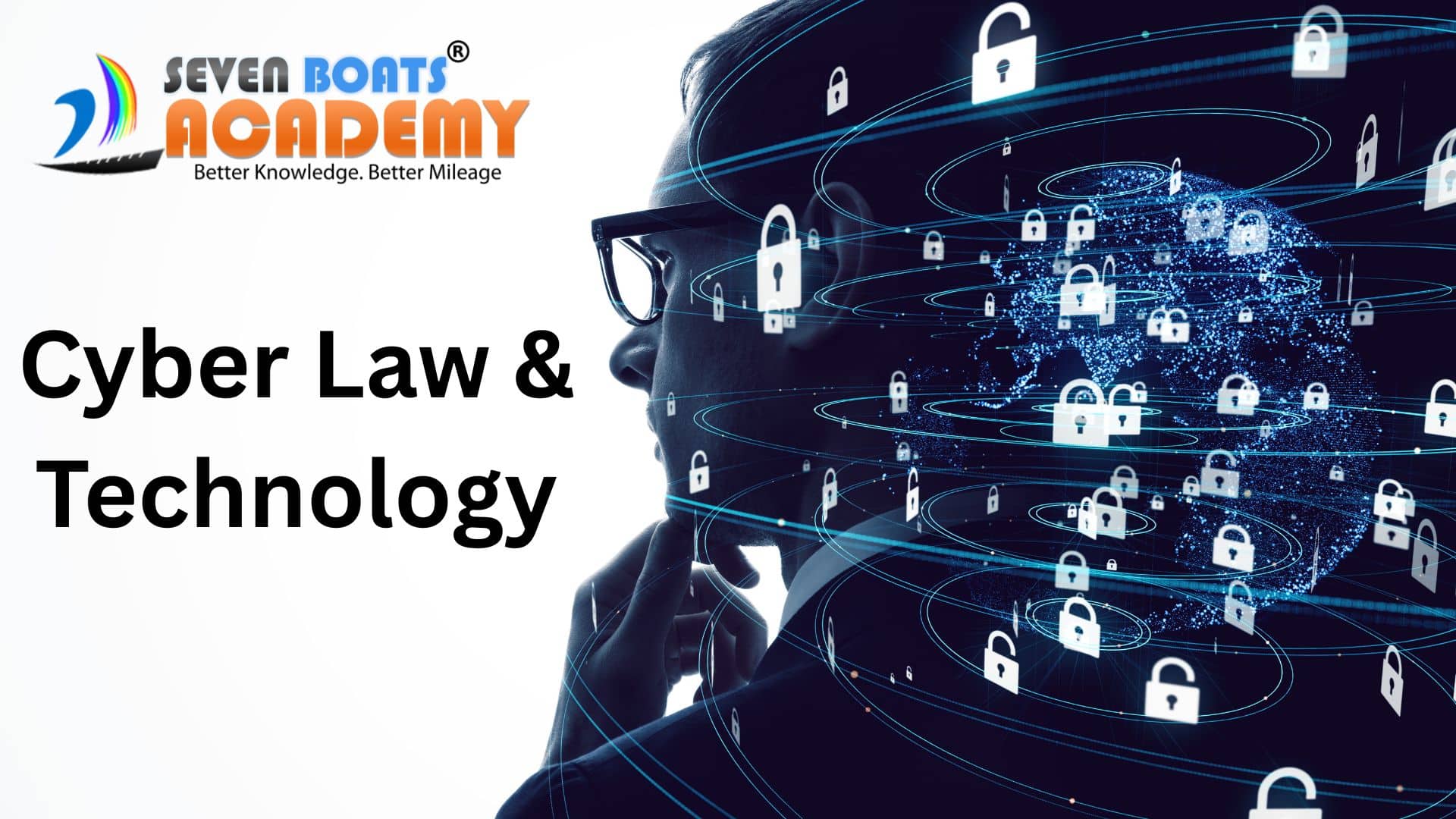
MBA Class Notes: Cyber Law & Technology
IT Act & Cyber Law: Key Concepts for MBA [Lecture Notes]
Course: MBA Program
Module: Legal Aspects of Business / IT Management (or relevant module)
Topics: Overview of Computer & Web Technology, Need for Cyber Law, Evolution, Cyber Jurisprudence, Jurisdiction Issues, Types of Jurisdiction, Jurisdiction under IT Act, 2000.
1. Overview of Computer & Web Technology
What are the fundamental components of computer and web technology relevant to business?
- Computers: Electronic devices that process data. Key components include:
- Hardware: Physical parts (CPU, memory/RAM, storage/HDD/SSD, input/output devices).
- Software: Instructions that tell hardware what to do (Operating Systems like Windows/macOS/Linux, Application Software like MS Office, SAP, Tally).
- Networks: Interconnected computers allowing communication and resource sharing (LAN, WAN, Internet).
- Internet: A global network of networks connecting millions of computers worldwide using standard protocols (TCP/IP). It’s the infrastructure.
- World Wide Web (WWW): A system of interlinked hypertext documents accessed via the Internet. It uses protocols like HTTP. It’s the service running on the Internet. Key elements:
- Web Browsers: Software to access web pages (Chrome, Firefox).
- Web Servers: Computers hosting websites.
- Websites/Web Pages: Documents formatted in HTML, accessed via URLs.
- Cloud Computing: Delivery of computing services (servers, storage, databases, networking, software, analytics, intelligence) over the Internet (“the cloud”). Examples: AWS, Azure, Google Cloud. Offers scalability, flexibility, and cost-efficiency for businesses.
- Mobile Technology: Smartphones, tablets, and associated apps, enabling ubiquitous access to information and services.
Why is understanding this technology crucial for MBA students?
- Business Operations: Modern businesses rely heavily on IT for efficiency, communication, data management, and decision-making.
- E-Commerce: Understanding web technology is fundamental for online sales, marketing, and customer interaction.
- Data Security: Awareness of how data is stored, processed, and transmitted is vital for protecting sensitive business information.
- Legal Compliance: Many legal issues (covered next) arise directly from the use of these technologies.
(Potential Exam Question: Explain the difference between the Internet and the World Wide Web and discuss the significance of cloud computing for modern businesses.)
2. Need for Cyber Law & Its Evolution
Why did the need for Cyber Law arise?
The traditional legal framework was designed for the physical world and struggled to address issues unique to the borderless, intangible, and rapidly evolving digital realm (cyberspace). Key reasons for needing specific Cyber Laws:
- New Types of Crimes: Hacking, data theft, online fraud, cyberstalking, phishing, identity theft, spreading malware, denial-of-service attacks.
- Jurisdictional Challenges: Determining which country’s laws apply when a crime involves parties in different locations.
- Anonymity & Impersonation: Difficulty in identifying perpetrators hiding behind digital anonymity.
- Data Protection & Privacy: Need to regulate the collection, storage, and use of personal data online.
- Intellectual Property Protection: Protecting digital content (software, music, e-books) from piracy.
- E-Commerce Regulation: Establishing rules for online contracts, digital signatures, and consumer protection.
- Evidentiary Issues: Admissibility and authentication of electronic records in court.
How has Cyber Law evolved?
- Early Stages (Pre-Internet): Focused on computer misuse (e.g., unauthorized access to mainframes). Laws were often extensions of existing property or trespass laws.
- Rise of the Internet (1990s): Recognition of the need for specific legislation. Focus shifted to e-commerce, digital signatures, and basic cybercrimes.
- International: UNCITRAL Model Law on Electronic Commerce (1996) provided a template for countries.
- India: The Information Technology Act, 2000 (IT Act, 2000) was enacted, based largely on the UNCITRAL model.
- Post-2000: Laws evolved to address new threats and technologies:
- Increased focus on data protection and privacy (e.g., GDPR in Europe, amendments to India’s IT Act).
- Addressing sophisticated cybercrimes (cyber terrorism, advanced phishing).
- Regulation of intermediaries (ISPs, social media platforms).
- International cooperation treaties (e.g., Budapest Convention on Cybercrime).
- Current Trends: Focus on AI regulation, IoT security, cryptocurrency, and platform accountability.
(Potential Exam Question: Discuss the key factors that necessitated the development of specific Cyber Laws, distinct from traditional laws.)
(Potential Exam Question: Trace the evolution of Cyber Law, highlighting key international and Indian milestones.)
3. Cyber Jurisprudence at International and Indian Levels
What is Cyber Jurisprudence?
Cyber Jurisprudence refers to the study, philosophy, and application of law in relation to cyberspace. It involves developing legal principles and frameworks to govern online activities and resolve disputes arising from them.
International Level:
- Challenges: Lack of a single, universally accepted international treaty governing all aspects of cyberspace. Enforcement across borders remains difficult.
- Key Efforts & Instruments:
- UNCITRAL Model Laws: Provide guidance for national legislation (e.g., E-Commerce, Electronic Signatures).
- Budapest Convention on Cybercrime (Council of Europe): The most significant international treaty addressing cybercrime. Aims to harmonize national laws, improve investigation techniques, and increase international cooperation. (India is not a signatory but aligns with many principles).
- WTO Agreements: Include provisions relevant to e-commerce and trade in digital services.
- WIPO Treaties: Address intellectual property protection in the digital environment.
- Bilateral/Multilateral Agreements: Countries often have specific agreements for cooperation on cybercrime investigations (e.g., Mutual Legal Assistance Treaties – MLATs).
- Ongoing Debates: Internet governance (role of ICANN, governments, private sector), data localization vs. free flow of data, state-sponsored cyber activities.
Indian Level:
- Primary Legislation: The Information Technology Act, 2000 (amended significantly in 2008).
- Key Features of Indian Cyber Jurisprudence:
- Legal Recognition: Grants legal validity to electronic records and digital signatures.
- Cybercrime Definitions: Defines various offenses like hacking, data theft, identity theft, publishing obscene material, cyber terrorism, etc., and prescribes punishments.
- Intermediary Liability: Defines the responsibilities and liabilities of intermediaries (ISPs, social media platforms) under a ‘safe harbour’ framework (subject to due diligence).
- Adjudication Mechanism: Establishes Adjudicating Officers and the Cyber Appellate Tribunal (now merged with TDSAT) for handling civil contraventions under the Act.
- Data Protection: Section 43A (prior to the DPDP Act 2023) imposed liability for failure to protect sensitive personal data. Now largely governed by the Digital Personal Data Protection Act, 2023.
- Jurisdiction: Section 75 provides for extra-territorial jurisdiction (discussed below).
- Other Relevant Laws: Indian Penal Code (IPC), Indian Evidence Act (amended to accept electronic evidence), Copyright Act, Consumer Protection Act, and now the Digital Personal Data Protection Act, 2023.
(Potential Exam Question: Compare and contrast the approaches to cyber jurisprudence at the international and Indian levels. What are the main challenges at the international level?)
(Potential Exam Question: What are the core objectives and features of the Information Technology Act, 2000 in establishing cyber jurisprudence in India?)
4. Issues of Jurisdiction in Cyberspace
What makes jurisdiction complex in cyberspace?
Jurisdiction refers to the power of a court to hear and decide a case. In cyberspace, traditional jurisdictional rules based on physical presence or location become problematic due to:
- Borderless Nature: The internet transcends geographical boundaries. An act initiated in country A can cause harm in country B, involving servers in country C.
- Anonymity: Difficulty in identifying the real-world location of users or servers.
- Intangibility: Lack of physical assets or presence in a particular territory.
- Speed & Scale: Actions can have instantaneous global effects.
Key Questions:
- Which country’s court has the authority to hear a case involving online activity?
- Which country’s laws should apply (Choice of Law)?
- How can judgments be enforced across borders?
Why is this important for businesses?
A business operating online (e.g., an e-commerce site) could potentially be sued in any jurisdiction where its website is accessible or where its actions have an effect, exposing it to unfamiliar laws and legal systems.
(Potential Exam Question: Explain why establishing jurisdiction is a significant challenge in cyberspace compared to the physical world.)
5. Types of Jurisdiction: Minimum Contacts, Sliding Scale, Effects Test
Courts, particularly in the US (whose jurisprudence heavily influences international norms), have developed several tests to determine if they can exercise jurisdiction over non-resident defendants based on their online activities.
a) Minimum Contacts Test:
- Origin: Established in traditional (offline) law (Int’l Shoe Co. v. Washington).
- Principle: A court can exercise jurisdiction over a non-resident defendant if they have sufficient “minimum contacts” with the forum state (the state where the court is located) such that exercising jurisdiction does not offend “traditional notions of fair play and substantial justice.”
- Application to Cyberspace: Requires evaluating the nature and quality of the defendant’s online interactions directed towards the forum state. Did the defendant purposefully avail themselves of the privilege of conducting activities within the forum state? Simply having a passive website accessible everywhere might not be enough.
b) Sliding Scale Test (Zippo Test):
- Origin: Zippo Manufacturing Co. v. Zippo Dot Com, Inc.
- Principle: Categorizes websites based on their interactivity to determine jurisdiction. It’s a spectrum:
- Active Websites: Defendants clearly conduct business over the internet with residents of the forum state (e.g., entering contracts, knowing transmission of files). Jurisdiction is likely proper.
- Passive Websites: Websites that merely make information available to interested viewers but do not solicit business or interaction. Jurisdiction is generally not proper.
- Interactive Websites (Middle Ground): Allow users to exchange information with the host computer. Jurisdiction is determined by examining the level and commercial nature of the exchange of information occurring on the website. The more interactive and commercially focused, the more likely jurisdiction is proper.
c) Effects Test (Calder Test):
- Origin: Calder v. Jones (pre-internet case involving libel).
- Principle: Jurisdiction is proper if the defendant’s intentional actions, performed outside the forum state, were expressly aimed at the forum state and caused harm within the forum state, which the defendant knew was likely to be suffered there.
- Application to Cyberspace: Useful in cases like online defamation, intellectual property infringement, or fraud where the harmful effect is felt primarily in the plaintiff’s home state, even if the defendant’s website/server is elsewhere. The focus is on the intended effect of the defendant’s online conduct within the forum.
(Potential Exam Question: Explain the ‘Sliding Scale’ test for determining jurisdiction in cyberspace, providing examples for each category.)
(Potential Exam Question: When might the ‘Effects Test’ be more appropriate than the ‘Minimum Contacts’ or ‘Sliding Scale’ tests for establishing jurisdiction? Give an example.)
6. Jurisdiction under the IT Act, 2000 (India)
How does the IT Act, 2000 address jurisdiction?
- Section 75: Act to apply for offence or contravention committed outside India.
- Principle (Extra-territorial Jurisdiction): The Act applies to any offence or contravention committed outside India by any person, irrespective of their nationality, IF the act involves a computer, computer system, or computer network located in India.
- Scope: This gives Indian courts broad jurisdiction. If a hacker in Russia attacks a server located in Mumbai, the IT Act, 2000 can apply, and Indian authorities can potentially prosecute (though practical enforcement depends on international cooperation).
- Implication for Businesses: Foreign companies targeting Indian consumers or using IT infrastructure in India can be subject to the provisions of the IT Act.
- Section 1(2): Extent: It extends to the whole of India.
- Section 46: Power to Adjudicate: Specifies that Adjudicating Officers have the power to adjudicate contraventions under the Act (e.g., Section 43 – damages for unauthorized access, data theft etc.). Their jurisdiction is typically based on where the cause of action arises or where the defendant resides/works.
Interplay with Civil Procedure Code (CPC):
- For civil suits (e.g., seeking damages beyond the scope of Adjudicating Officers, or for matters not covered by the IT Act like online defamation falling under IPC), the traditional rules of jurisdiction under the Code of Civil Procedure, 1908 apply.
- Section 20 of CPC: A suit can be filed where:
- The defendant resides or carries on business, OR
- Where the cause of action, wholly or in part, arises.
- “Cause of Action” in Cyberspace: Indian courts have interpreted this broadly. Accessing a defamatory website in India, making an online purchase from India, or suffering damage from hacking in India can give rise to a cause of action within India, potentially establishing jurisdiction even if the defendant is outside India (subject to principles like ‘forum non conveniens’ – whether India is the appropriate forum).
Case Law Examples (Illustrative):
- Courts have often applied principles similar to the ‘Effects Test’ or ‘Minimum Contacts’ when interpreting ’cause of action’ under the CPC in cyber cases, looking at whether the website targeted Indian users or had substantial effects in India.
(Potential Exam Question: Explain the concept of extra-territorial jurisdiction as provided under Section 75 of the IT Act, 2000. What is its significance?)
(Potential Exam Question: How do Indian courts determine jurisdiction in civil matters arising from online activities, considering both the IT Act and the Code of Civil Procedure?)
Conclusion for MBA Students:
Understanding the technological landscape and the evolving legal framework governing it is not just an IT or legal issue; it’s a core business concern. Issues of data security, online contracts, intellectual property, consumer trust, and potential legal liability in multiple jurisdictions directly impact business strategy, risk management, and profitability. Awareness of cyber law principles, particularly jurisdiction, is essential for navigating the complexities of digital commerce and global operations.
Related reading: Cybersecurity practical guide for MBA students



1 responses on "Cyber Law & Technology - MBA Lecture Notes"